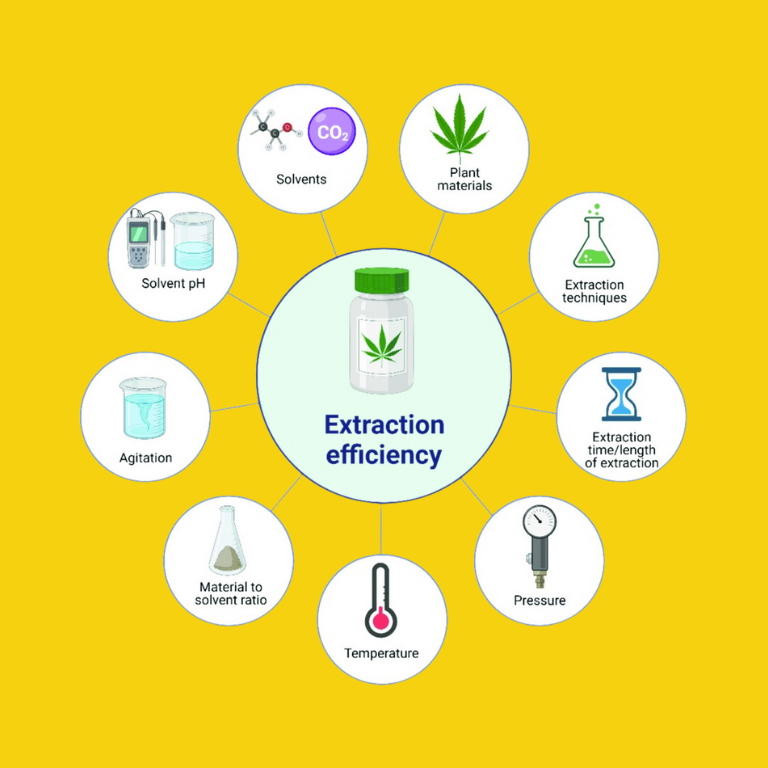Efficient Cannabinoid Extraction Using Botanical Techniques

Cannabinoid extraction is a cornerstone of the cannabis industry, producing potent compounds used in medicinal, recreational, and wellness products. While various methods have emerged to extract cannabinoids from the cannabis plant, botanical extraction techniques are gaining popularity for their efficiency, sustainability, and ability to produce high-quality extracts. This article explores the process, advantages, and considerations of using botanical techniques for cannabinoid extraction, offering a comprehensive look at how these methods can meet industry demands for potency, purity, and scalability.
Understanding Cannabinoid Extraction
Cannabinoid extraction is the process of separating cannabinoids—such as THC, CBD, CBG, and others—from the cannabis plant. These compounds are known for their therapeutic effects, including pain relief, anti-inflammatory properties, and mental wellness benefits. Effective extraction methods are crucial to isolate and concentrate these cannabinoids for incorporation into products like oils, edibles, topicals, and more.
While traditional extraction methods include solvents like butane and ethanol, botanical techniques, such as cold-pressing and CO₂ extraction, focus on preserving the plant’s natural essence without introducing harmful chemicals. These methods are increasingly favored for producing cleaner, purer cannabinoid products.
Popular Botanical Techniques for Cannabinoid Extraction
Several botanical techniques stand out for their effectiveness, environmental impact, and potential to preserve the cannabinoid profile of the plant. Each method offers unique benefits and may be chosen based on the specific needs of the final product.
CO₂ Supercritical Extraction
One of the most popular methods in the industry, CO₂ supercritical extraction uses pressurized carbon dioxide to extract cannabinoids. By controlling temperature and pressure, CO₂ can be converted into a supercritical state—meaning it has properties of both a liquid and a gas. This allows CO₂ to dissolve cannabinoids and terpenes from the plant material without leaving toxic residues.
Advantages:
Purity and Safety: CO₂ is non-toxic and leaves no residue, resulting in a clean extract.
Versatility: This method can be tuned to extract specific cannabinoids or terpenes by adjusting pressure and temperature, creating highly customized products.
Environmental Impact: CO₂ is reusable and does not produce harmful byproducts, making it eco-friendly.
Cold Press Extraction
Cold pressing is one of the oldest extraction techniques, and it works well for plant materials with naturally occurring oils. This technique involves applying mechanical pressure to crush the plant material and release cannabinoids without the use of heat or solvents.
Advantages:
Chemical-Free: Cold pressing doesn’t require any solvents, which preserves the natural profile of the plant.
Minimal Degradation: Since there is no heat involved, cannabinoids and terpenes are less likely to degrade, resulting in a potent, aromatic product.
Simplicity: Cold pressing is straightforward and cost-effective, making it an appealing choice for smaller-scale extractions or artisanal products.
Steam Distillation
Steam distillation is a traditional method of extracting essential oils, commonly used in aromatherapy. In this method, steam is passed through the plant material to release cannabinoids and terpenes. The steam containing these compounds is then condensed and collected.
Advantages:
Preservation of Terpenes: This method captures volatile terpenes effectively, allowing for a full-spectrum extract.
Simple Process: Steam distillation is a well-established and straightforward technique that doesn’t require complex machinery.
Safety: Since steam distillation only uses water and heat, it is a non-toxic and safe extraction method.
Solventless Ice Water Extraction
Ice water extraction uses cold water and ice to separate trichomes—the part of the plant that contains cannabinoids and terpenes—from the plant material. This method is popular for producing bubble hash, a highly concentrated form of cannabis.
Advantages:
Preserves Potency: Ice water extraction retains the cannabinoid and terpene profiles, resulting in a high-quality product.
Non-Toxic: No chemicals or solvents are used, making this one of the safest extraction methods.
Ideal for Concentrates: This method is particularly useful for creating concentrates that are used in edibles, topicals, or other high-potency applications.
Key Steps in Botanical Extraction Processes
While each botanical extraction method has its nuances, the general steps involved in cannabinoid extraction remain consistent. Understanding these steps is essential for optimizing the efficiency and quality of the extraction.
Preparation of Plant Material: The cannabis plant material must be properly dried and ground to increase the surface area, allowing more efficient extraction.
Extraction Process: This involves applying pressure, temperature, solvents, or other mechanisms to separate cannabinoids from the plant. Each method—CO₂, cold pressing, steam distillation, or ice water—varies in the equipment and parameters used.
Filtration and Purification: After extraction, the solution is filtered to remove any residual plant material. Purification may involve further processes like winterization or distillation to isolate specific cannabinoids and remove impurities.
Concentration and Final Processing: The cannabinoid-rich extract is then concentrated to the desired potency, which can involve evaporation or other processes to remove excess water or solvent.
Quality Control Testing: Testing for cannabinoid potency, purity, and the presence of contaminants is essential to ensure a safe, effective final product that complies with industry standards.
Advantages of Botanical Extraction for Cannabinoids
Botanical extraction methods offer several key advantages over traditional solvent-based extractions, especially when it comes to purity, safety, and environmental sustainability.
Improved Purity and Safety
Botanical methods like CO₂ extraction avoid the use of toxic solvents, resulting in a purer product with minimal residuals. This safety advantage is essential in the cannabis industry, where products are often used medicinally and require the highest safety standards.
Preservation of Cannabinoid and Terpene Profiles
Botanical extraction techniques excel at preserving the natural cannabinoid and terpene profiles of the plant. Techniques like cold pressing and CO₂ supercritical extraction avoid the heat and chemicals that can degrade cannabinoids and terpenes, yielding extracts that retain the full-spectrum benefits of the plant.
Eco-Friendly and Sustainable
The cannabis industry increasingly prioritizes environmental responsibility. Botanical extraction methods are often more eco-friendly than traditional solvent extractions, as they use fewer chemicals and produce minimal waste. CO₂ extraction, in particular, is highly sustainable because CO₂ can be recycled and reused in the process.
Challenges and Considerations in Botanical Extraction
While botanical extraction methods offer many benefits, they also come with challenges. These must be considered carefully, especially when scaling operations or targeting specific cannabinoids.
Initial Cost and Equipment Requirements
Botanical extraction methods like CO₂ supercritical extraction require specialized equipment, which can be costly to acquire and maintain. Cold press and steam distillation setups are generally less expensive, but still require careful setup to ensure product quality and efficiency.
Precision and Consistency
Achieving a consistent extract is crucial, especially for medical or high-potency products. Botanical methods require precise control of parameters like temperature, pressure, and timing. Consistency can be more challenging in botanical methods than in traditional solvent extractions, which often produce a more uniform extract.
Yield and Efficiency
While botanical extraction methods are efficient, they can sometimes produce lower yields compared to methods like ethanol extraction. The choice of method should balance the yield with the desired purity and quality of the final product.
Innovations in Botanical Extraction Techniques
Advancements in technology are helping to address some of the challenges associated with botanical extractions. New methods are being developed to optimize yield, efficiency, and purity, while retaining the benefits of botanical techniques.
Enhanced CO₂ Extraction: Innovations in CO₂ extraction technology allow for finer control over pressure and temperature, improving yield and enabling the extraction of specific cannabinoids and terpenes.
Ultrasound-Assisted Extraction: This method uses ultrasonic waves to disrupt plant cell walls, making cannabinoids easier to extract. Ultrasound-assisted extraction can be combined with CO₂ or cold press methods to increase efficiency.
Microwave-Assisted Extraction: Microwave technology is emerging as a way to expedite botanical extraction. The method accelerates the process by heating water molecules within the plant, releasing cannabinoids quickly and efficiently.
Applications of Botanical Cannabinoid Extraction in the Industry
Cannabinoid extraction using botanical techniques has versatile applications, serving both medicinal and recreational markets. The choice of extraction method often depends on the intended use of the final product.
Medical Cannabis Products: Full-spectrum oils and high-CBD extracts are popular in medical cannabis, as these products offer therapeutic benefits. Cold press and CO₂ extraction are particularly suitable for creating high-purity medicinal extracts.
Recreational Products: For recreational products, manufacturers may emphasize potency and flavor. Steam distillation and CO₂ extraction allow for a balanced cannabinoid and terpene profile, enhancing the user experience.
Wellness and Skincare: Botanical extractions produce clean, safe extracts for wellness and skincare products. Many wellness brands prefer botanical methods for their “natural” appeal and reduced risk of skin irritants.
Edibles: Solventless methods like ice water extraction are ideal for producing extracts that can be safely consumed in edibles. These methods avoid residues that can alter taste or introduce toxins.
The Future of Botanical Cannabinoid Extraction
Botanical techniques are transforming cannabinoid extraction, offering a path toward a safer, cleaner, and more sustainable cannabis industry. As consumer demand for high-quality cannabis products grows, so does the need for advanced extraction methods that prioritize purity and environmental impact. Emerging innovations in CO₂, ultrasound, and microwave-assisted extraction promise to further enhance the efficiency and versatility of botanical techniques.
As the cannabis industry continues to expand, botanical extraction techniques will likely play an increasingly prominent role. By combining traditional botanical methods with cutting-edge technology, the industry can deliver potent, safe, and effective cannabis products that meet both regulatory standards and consumer expectations.
In summary, efficient cannabinoid extraction using botanical techniques is an exciting and evolving field, offering numerous benefits for producers and consumers alike. By focusing on safety, purity, and sustainability, botanical extractions represent the future of high-quality cannabis products and a more responsible cannabis industry.











